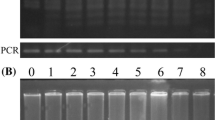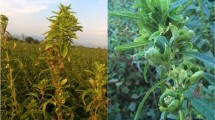Abstract
Phytophthora melonis is a widespread and devastating pathogen for the Cucurbitaceae family. Early and accurate detection of P. melonis is essential to control the disease in the field. To establish a simple, visual, and rapid detection system for P. melonis, we developed nested polymerase chain reaction (PCR) and loop-mediated isothermal amplification (LAMP) systems based on the Ras-related protein (Ypt1) gene. All 36 isolates of P. melonis, from geographically distinct counties in China, yielded positive detection results on LAMP or nested PCR assays. No cross reaction was observed with other oomycetes or fungal pathogens. A sensitivity assay showed that both methods had a detection limit of 10 fg genomic DNA. We also detected P. melonis in diseased cucumber tissues and soils, and evaluated positive detection rates using LAMP, nested PCR, and conventional isolation methods. The results suggest that the LAMP assay has the greatest potential for active detection of P. melonis in regions that are at risk of contracting the disease, and for use in resource-poor settings.



Similar content being viewed by others
References
Blair, J. E., Coffey, M. D., Park, S. Y., Geiser, D. M., & Kang, S. (2008). A multi-locus phylogeny for Phytophthora utilizing markers derived from complete genome sequences. Fungal Genetics and Biology, 45, 266–277.
Chen, L., Zhu, S., Lu, X., Pang, Z., Cai, M., & Liu, X. (2012). Assessing the risk that Phytophthora melonis can develop a point mutation (V1109L) in CesA3 conferring resistance to carboxylic ccid amide fungicides. PLoS ONE, 7, e42069.
Dai, T. T., Lu, C. C., Lu, J., Dong, S., Ye, W., Wang, Y., et al. (2012). Development of a loop-mediated isothermal amplification assay for detection of Phytophthora sojae. FEMS Microbiology Letters, 334, 27–34.
Guharoy, S., Bhattacharyya, S., Mukherjee, S., Mandal, N., & Khatua, D. (2006). Phytophthora melonis associated with fruit and vine rot disease of pointed gourd in India as revealed by RFLP and sequencing of ITS region. Journal of Phytopathology, 154, 612–615.
Haubruck, H., Disela, C., Wagner, P., & Gallwitz, D. (1987). The ras-related ypt protein is an ubiquitous eukaryotic protein: isolation and sequence analysis of mouse cDNA clones highly homologous to the yeast YPT1 gene. The EMBO Journal, 6, 4049.
Henson, J. M., & French, R. (1993). The polymerase chain reaction and plant disease diagnosis. Annual Review of Phytopathology, 31, 81–109.
Ho, H., Gallegly, M., & Hong, C. (2007). Redescription of Phytophthora melonis. Mycotaxon, 102, 339–345.
Kaneko, H., Kawana, T., Fukushima, E., & Suzutani, T. (2007). Tolerance of loop-mediated isothermal amplification to a culture medium and biological substances. Journal of Biochemical and Biophysical Methods, 70, 499–501.
Katsura, K. (1976). Two new species of Phytophthora causing damping-off of cucumber and trunk rot of chestnut. Transactions of the Mycological Society of Japan, 17(3/4), 238–242.
Kroon, L., Bakker, F., Van Den Bosch, G., Bonants, P., & Flier, W. (2004). Phylogenetic analysis of Phytophthora species based on mitochondrial and nuclear DNA sequences. Fungal Genetics and Biology, 41, 766–782.
Li, B., Du, J., Lan, C., Liu, P., Weng, Q., & Chen, Q. (2013). Development of a loop-mediated isothermal amplification assay for rapid and sensitive detection of Fusarium oxysporum f. sp. cubense race 4. European Journal of Plant Pathology, 135, 903–911.
Mao, Z., Qiu, Y., Zheng, L., Chen, J., & Yang, J. (2012). Development of a visual loop-mediated isothermal amplification method for rapid detection of the bacterial pathogen Pseudomonas putida of the large yellow croaker (Pseudosciaena croacea). Journal of Microbiological Methods, 89, 179–184.
Martin, F. N., Abad, Z. G., Balci, Y., & Ivors, K. (2012). Identification and detection of phytophthora: reviewing our progress, identifying our needs. Plant Disease, 96, 1080–1103.
Meng, J., & Wang, Y. (2010). Rapid detection of Phytophthora nicotianae in infected tobacco tissues and soil samples based on its Ypt1 gene. Journal of Phytopathology, 158, 1–7.
Mirabolfathy, M., Cooke, D. E. L., Duncan, J. M., Williams, N. A., Ershad, D., & Alizadeh, A. (2001). Phytophthora pistaciae sp. nov. and P. melonis: the principal causes of pistachio gummosis in Iran. Mycological Research, 105, 1166–1175.
Mori, Y., & Notomi, T. (2009). Loop-mediated isothermal amplification (LAMP): a rapid, accurate, and cost-effective diagnostic method for infectious diseases. Journal of Infection and Chemotherapy, 15, 62–69.
Nagamine, K., Watanabe, K., Ohtsuka, K., Hase, T., & Notomi, T. (2001). Loop-mediated isothermal amplification reaction using a nondenatured template. Clinical Chemistry, 47, 1742–1743.
Nagamine, K., Hase, T., & Notomi, T. (2002). Accelerated reaction by loop-mediated isothermal amplification using loop primers. Molecular and Cellular Probes, 16, 223–229.
Nakao, R., Stromdahl, E. Y., Magona, J. W., Faburay, B., Namangala, B., Malele, I., et al. (2010). Development of loop-mediated isothermal amplification (LAMP) assays for rapid detection of Ehrlichia ruminantium. BMC Microbiology, 10, 296.
Niu, J., Jian, H., Guo, Q., Chen, C., Wang, X., Liu, Q., et al. (2012). Evaluation of loop-mediated isothermal amplification (LAMP) assays based on 5S rDNA-IGS2 regions for detecting Meloidogyne enterolobii. Plant Pathology, 61, 809–819.
Notomi, T., Okayama, H., Masubuchi, H., Yonekawa, T., Watanabe, K., Amino, N., et al. (2000). Loop-mediated isothermal amplification of DNA. Nucleic Acids Research, 28, E63.
Osawa, R., Yoshida, A., Masakiyo, Y., Nagashima, S., Ansai, T., Watari, H., et al. (2007). Rapid detection of Actinobacillus actinomycetemcomitans using a loop-mediated isothermal amplification method. Oral Microbiology and Immunology, 22, 252–259.
Pavón, C., Babadoost, M., & Lambert, K. (2008). Quantification of Phytophthora capsici oospores in soil by sieving-centrifugation and real-time polymerase chain reaction. Plant Disease, 92, 143–149.
Poppert, S., Essig, A., Stoehr, B., Steingruber, A., Wirths, B., Juretschko, S., et al. (2005). Rapid diagnosis of bacterial meningitis by real-time PCR and fluorescence in situ hybridization. Journal of Clinical Microbiology, 43, 3390–3397.
Rigano, L. A., Marano, M. R., Castagnaro, A. P., Do Amaral, A. M., & Vojnov, A. A. (2010). Rapid and sensitive detection of Citrus Bacterial Canker by loop-mediated isothermal amplification combined with simple visual evaluation methods. BMC Microbiology, 10, 176.
Ristaino, J. (1990). Intraspecific variation among isolates of Phytophthora capsici from pepper and cucurbit fields in North Carolina. Phytopathology, 80, 1253–1259.
Schena, L., & Cooke, D. E. L. (2006). Assessing the potential of regions of the nuclear and mitochondrial genome to develop a “molecular tool box” for the detection and characterization of Phytophthora species. Journal of Microbiological Methods, 67, 70–85.
Schena, L., Hughes, K. J. D., & Cooke, D. E. L. (2006). Detection and quantification of Phytophthora ramorum, P. kernoviae, P. citricola and P. quercina in symptomatic leaves by multiplex real-time PCR. Molecular Plant Pathology, 7, 365–379.
Schena, L., Duncan, J., & Cooke, D. (2008). Development and application of a PCR-based ‘molecular tool box’ for the identification of Phytophthora species damaging forests and natural ecosystems. Plant Pathology, 57, 64–75.
Silvar, C., Duncan, J., Cooke, D., Williams, N., Díaz, J., & Merino, F. (2005). Development of specific PCR primers for identification and detection of Phytophthora capsici Leon. European Journal of Plant Pathology, 112, 43–52.
Skottman, T., Piiparinen, H., Hyytiäinen, H., Myllys, V., Skurnik, M., & Nikkari, S. (2007). Simultaneous real-time PCR detection of Bacillus anthracis, Francisella tularensis and Yersinia pestis. European Journal of Clinical Microbiology and Infectious Diseases, 26, 207–211.
Tomlinson, J., Barker, I., & Boonham, N. (2007). Faster, simpler, more-specific methods for improved molecular detection of Phytophthora ramorum in the field. Applied and Environmental Microbiology, 73, 4040–4047.
Tooley, P., Bunyard, B., Carras, M., & Hatziloukas, E. (1997). Development of PCR primers from internal transcribed spacer region 2 for detection of Phytophthora species infecting potatoes. Applied and Environmental Microbiology, 63, 1467–1475.
Trout, C., Ristaino, J., Madritch, M., & Wangsomboondee, T. (1997). Rapid detection of Phytophthora infestans in late blight-infected potato and tomato using PCR. Plant Disease, 81, 1042–1048.
Wang, Y., Ren, Z., & Zheng, X. (2007). Detection of Phytophthora melonis in samples of soil, water, and plant tissue with polymerase chain reaction. Canadian Journal of Plant Pathology, 29, 172–181.
Yamazaki, W., Kumeda, Y., Misawa, N., Nakaguchi, Y., & Nishibuchi, M. (2010). Development of a loop-mediated isothermal amplification assay for sensitive and rapid detection of the tdh and trh genes of Vibrio parahaemolyticus and related Vibrio species. Applied and Environmental Microbiology, 76, 820–828.
Acknowledgments
This work was supported by grants from the Natural Science Foundation for Distinguished Young Scholars of Fujian Province (2011J06010), Doctoral Foundation of FAAS (2012DBS-2), and Special Fund for Agro-scientific Research in the Public Interest (201303018; 200903034).
Author information
Authors and Affiliations
Corresponding authors
Additional information
Qinghe Chen and Benjin Li contributed equally to this work and are considered co-first authors.
Electronic supplementary material
Below is the link to the electronic supplementary material.
ESM 1
(DOC 64 kb)
Rights and permissions
About this article
Cite this article
Chen, Q., Li, B., Liu, P. et al. Development and evaluation of specific PCR and LAMP assays for the rapid detection of Phytophthora melonis . Eur J Plant Pathol 137, 597–607 (2013). https://doi.org/10.1007/s10658-013-0273-9
Accepted:
Published:
Issue Date:
DOI: https://doi.org/10.1007/s10658-013-0273-9




